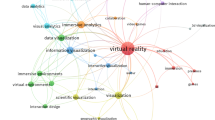Abstract
We report the results of an experiment conducted to examine the effects of immersive viewing on a common spatial knowledge acquisition task of spatial updating task in a spherical panoramic environment (SPE). A spherical panoramic environment, such as Google Street View, is an environment that is comprised of spherical images captured at regular intervals in a real world setting augmented with virtual navigational aids such as paths, dynamic maps, and textual annotations. Participants navigated the National Mall area of Washington, DC, in Google Street View in one of two viewing conditions; desktop monitor or a head-mounted display with a head orientation tracker. In an exploration phase, participants were first asked to navigate and observe landmarks on a pre-specified path. Then, in a testing phase, participants were asked to travel the same path and to rotate their view in order to look in the direction of the perceived landmarks at certain waypoints. The angular difference between participants’ gaze directions and the landmark directions was recorded. We found no significant difference between the immersive and desktop viewing conditions on participants’ accuracy of direction to landmarks as well as no difference in their sense of presence scores. However, based on responses to a post-experiment questionnaire, participants in both conditions tended to use a cognitive or procedural technique to inform direction to landmarks. Taken together, these findings suggest that in both conditions where participants experience travel based on teleportation between waypoints, the visual cues available in the SPE, such as street signs, buildings and trees, seem to have a stronger influence in determining the directions to landmarks than the egocentric cues such as first-person perspective and natural head-coupled motion experienced in the immersive viewing condition.







Similar content being viewed by others
References
Batschelet E (1965) Statistical methods for the analysis of problems in animal orientation and certain biological rhythms. American Institute of Biological Science, Washington, DC
Batschelete E (1978) Second-order statistical analysis of directions. Animal Migration, Navigation and Homing, 1–24
Belongie S (2012) Rodrigues’ rotation formula. mathworld—a wolfram web resource, created by Eric W. Weisstein. Retrieved April 2012. http://mathworld.wolfram.com/RodriguesRotationFormula.html
Bliss JP, Tidwell PD, Guest MA (1997) The effectiveness of virtual reality for administering spatial navigation training to firefighters. Presence 6:73–86
Bowman DA, Kruijff E, LaViola JJ, Paupyrev I (2001) An introduction to 3D user interface design. Presence 10(1):96–108
Chance SS, Beall AC, Loomis JM (1998) Locomotion mode affects the updating of objects encountered during travel: the contribution of vestibular and proprioceptive inputs to path integration. Presence 7(2):168–178
Darken RP, Sibert JL (1996) Navigating large virtual spaces. Int J Hum Comput Interact 8(1):49–71
Gallistel CR (1994) The organization of learning. MIT Press, Cambridge
Guilford JP, Zimmerman WS (1956) The Guilford-Zimmerman aptitude survey. J Appl Psychol 32:24–34
Hart SG, Staveland LE (1988) Development of NASA-TLX (task load index): results of empirical and theoretical research. Hum Ment Workload 1:139–183
Hu J, Fadel GM, Wood I, Napieralski P, Babu SV (2011) Prototyping process of a virtual-reality treadmill system for exploration of real world panoramic environments. In: Proceedings of the 5th international conference on advanced research in virtual and rapid prototyping, Leiria, Portugal, pp 699–701
Klatzky RL, Loomis JM, Beall AC, Chance SS, Reginald G, Golledge RG (1998) Spatial updating of self-position and orientation during real, imagined, and virtual locomotion. Psychol Sci 9(4):293–298
Mittelstaedt ML, Mittelstaedt H (1980) Homing by path integration in a mammal. Naturwissenschaften 67:566–567
Point Grey (2012) Ladybug2. http://www.ptgrey.com/products/ladybug2/ladybug2_360_video_camera.asp
Poucet B (1993) Spatial cognitive maps in animals: new hypotheses on their structure and neural mechanisms. Psychol Rev 100(2):163–182
Riecke BE, Wiener JM (2007) Can people not tell left from right in VR? Point-to-origin studies revealed qualitative errors in visual path integration. In: Proceedings of IEEE virtual reality 2007, Charlotte, NC, pp 3–10
Riecke BE, Feuereissen D, Rieser JJ, McNamara TP (2012) Self-motion illusions (vection) in VR—are they good for anything? In: Proceedings of the IEEE virtual reality 2012, Orange County, CA, pp 35–38
Satalich G (1995) Navigation and wayfinding in virtual reality: finding the proper tools and cues to enhance navigational awareness. Thesis at the University of Washington
Sigurdarson S, Milne AP, Feuereissen D, Riecke BE (2012) Can physical motions prevent disorientation in naturalistic VR? In: Proceedings of the IEEE vitrtual reality, Orange County, CA, pp 31–34
Thorndyke PW, Hayes-Roth B (1982) Differences in spatial knowledge acquired from maps and navigation. Cogn Psychol 14(4):560–589
Turvey MT, Burton G, Pagano CC, Solomon HY, Runeson S (1992) Role of the inertia tensor in perceiving object orientation by dynamic touch. J Exp Psychol Hum Percept Perform 3:714–727
Usoh M, Catena E, Arman S, Slater M (2000) Using presence questionnaires in reality. Presence 9(5):497–503
Waller D, Hunt E, Knapp D (1998) The transfer of spatial knowledge in virtual environment training. Presence 7(2):129–143
Wang RF, Crowell JA, Simons DJ, Irwin DE, Kramer AF, Ambinder MS, Thomas L, Gosney JL, Levinthal BR, Hsieh BB (1993) Spatial updating on an egocentric representation of space: effects of the number of objects. Psychon Bull Rev 13(2):281–286
Zanbaka C, Lok B, Babu SV, Xiao D, Ulinski A, Hodges LF (2004) Effects of travel techniques on cognition in virtual environments. In: Proceedings of the IEEE virtual reality, Chicago, IL, pp 149–286
Author information
Authors and Affiliations
Corresponding author
Rights and permissions
About this article
Cite this article
Napieralski, P.E., Altenhoff, B.M., Bertrand, J.W. et al. An evaluation of immersive viewing on spatial knowledge acquisition in spherical panoramic environments. Virtual Reality 18, 189–201 (2014). https://doi.org/10.1007/s10055-014-0245-1
Received:
Accepted:
Published:
Issue Date:
DOI: https://doi.org/10.1007/s10055-014-0245-1




